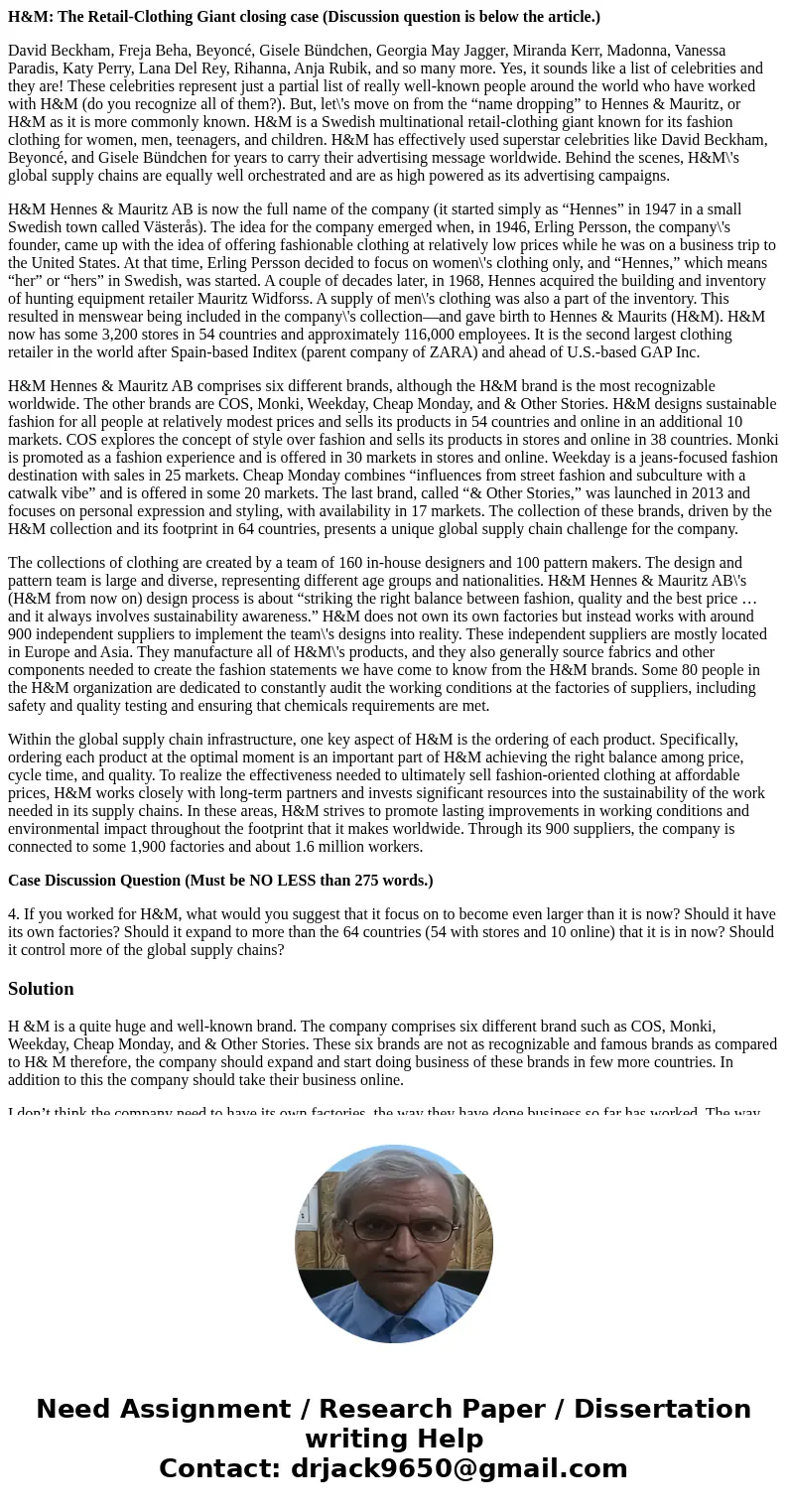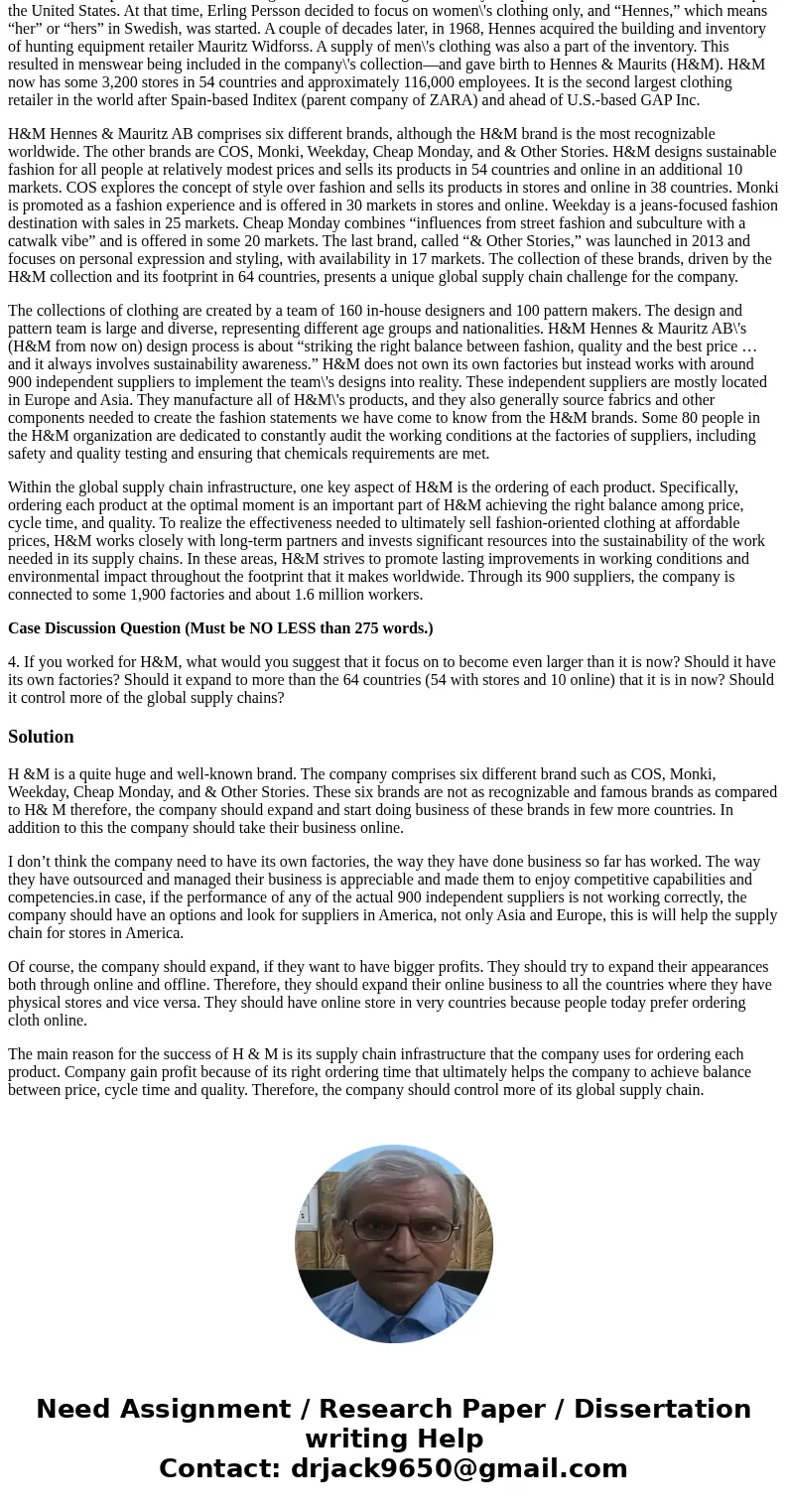HM The RetailClothing Giant closing case Discussion question
H&M: The Retail-Clothing Giant closing case (Discussion question is below the article.)
David Beckham, Freja Beha, Beyoncé, Gisele Bündchen, Georgia May Jagger, Miranda Kerr, Madonna, Vanessa Paradis, Katy Perry, Lana Del Rey, Rihanna, Anja Rubik, and so many more. Yes, it sounds like a list of celebrities and they are! These celebrities represent just a partial list of really well-known people around the world who have worked with H&M (do you recognize all of them?). But, let\'s move on from the “name dropping” to Hennes & Mauritz, or H&M as it is more commonly known. H&M is a Swedish multinational retail-clothing giant known for its fashion clothing for women, men, teenagers, and children. H&M has effectively used superstar celebrities like David Beckham, Beyoncé, and Gisele Bündchen for years to carry their advertising message worldwide. Behind the scenes, H&M\'s global supply chains are equally well orchestrated and are as high powered as its advertising campaigns.
H&M Hennes & Mauritz AB is now the full name of the company (it started simply as “Hennes” in 1947 in a small Swedish town called Västerås). The idea for the company emerged when, in 1946, Erling Persson, the company\'s founder, came up with the idea of offering fashionable clothing at relatively low prices while he was on a business trip to the United States. At that time, Erling Persson decided to focus on women\'s clothing only, and “Hennes,” which means “her” or “hers” in Swedish, was started. A couple of decades later, in 1968, Hennes acquired the building and inventory of hunting equipment retailer Mauritz Widforss. A supply of men\'s clothing was also a part of the inventory. This resulted in menswear being included in the company\'s collection—and gave birth to Hennes & Maurits (H&M). H&M now has some 3,200 stores in 54 countries and approximately 116,000 employees. It is the second largest clothing retailer in the world after Spain-based Inditex (parent company of ZARA) and ahead of U.S.-based GAP Inc.
H&M Hennes & Mauritz AB comprises six different brands, although the H&M brand is the most recognizable worldwide. The other brands are COS, Monki, Weekday, Cheap Monday, and & Other Stories. H&M designs sustainable fashion for all people at relatively modest prices and sells its products in 54 countries and online in an additional 10 markets. COS explores the concept of style over fashion and sells its products in stores and online in 38 countries. Monki is promoted as a fashion experience and is offered in 30 markets in stores and online. Weekday is a jeans-focused fashion destination with sales in 25 markets. Cheap Monday combines “influences from street fashion and subculture with a catwalk vibe” and is offered in some 20 markets. The last brand, called “& Other Stories,” was launched in 2013 and focuses on personal expression and styling, with availability in 17 markets. The collection of these brands, driven by the H&M collection and its footprint in 64 countries, presents a unique global supply chain challenge for the company.
The collections of clothing are created by a team of 160 in-house designers and 100 pattern makers. The design and pattern team is large and diverse, representing different age groups and nationalities. H&M Hennes & Mauritz AB\'s (H&M from now on) design process is about “striking the right balance between fashion, quality and the best price … and it always involves sustainability awareness.” H&M does not own its own factories but instead works with around 900 independent suppliers to implement the team\'s designs into reality. These independent suppliers are mostly located in Europe and Asia. They manufacture all of H&M\'s products, and they also generally source fabrics and other components needed to create the fashion statements we have come to know from the H&M brands. Some 80 people in the H&M organization are dedicated to constantly audit the working conditions at the factories of suppliers, including safety and quality testing and ensuring that chemicals requirements are met.
Within the global supply chain infrastructure, one key aspect of H&M is the ordering of each product. Specifically, ordering each product at the optimal moment is an important part of H&M achieving the right balance among price, cycle time, and quality. To realize the effectiveness needed to ultimately sell fashion-oriented clothing at affordable prices, H&M works closely with long-term partners and invests significant resources into the sustainability of the work needed in its supply chains. In these areas, H&M strives to promote lasting improvements in working conditions and environmental impact throughout the footprint that it makes worldwide. Through its 900 suppliers, the company is connected to some 1,900 factories and about 1.6 million workers.
Case Discussion Question (Must be NO LESS than 275 words.)
4. If you worked for H&M, what would you suggest that it focus on to become even larger than it is now? Should it have its own factories? Should it expand to more than the 64 countries (54 with stores and 10 online) that it is in now? Should it control more of the global supply chains?
Solution
H &M is a quite huge and well-known brand. The company comprises six different brand such as COS, Monki, Weekday, Cheap Monday, and & Other Stories. These six brands are not as recognizable and famous brands as compared to H& M therefore, the company should expand and start doing business of these brands in few more countries. In addition to this the company should take their business online.
I don’t think the company need to have its own factories, the way they have done business so far has worked. The way they have outsourced and managed their business is appreciable and made them to enjoy competitive capabilities and competencies.in case, if the performance of any of the actual 900 independent suppliers is not working correctly, the company should have an options and look for suppliers in America, not only Asia and Europe, this is will help the supply chain for stores in America.
Of course, the company should expand, if they want to have bigger profits. They should try to expand their appearances both through online and offline. Therefore, they should expand their online business to all the countries where they have physical stores and vice versa. They should have online store in very countries because people today prefer ordering cloth online.
The main reason for the success of H & M is its supply chain infrastructure that the company uses for ordering each product. Company gain profit because of its right ordering time that ultimately helps the company to achieve balance between price, cycle time and quality. Therefore, the company should control more of its global supply chain.


 Homework Sourse
Homework Sourse